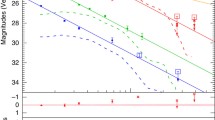Abstract
We discuss the multiband energy release in a model of a collapsing galactic nucleus, and we try to interpret the unique super-long cosmic gamma-ray event Swift J164449.3+573451 (GRB 110328A by early classification) in this scenario. Neutron stars and stellar-mass black holes can form evolutionary a compact self-gravitating subsystem in the galactic center. Collisions and merges of these stellar remnants during an avalanche contraction and collapse of the cluster core can produce powerful events in different bands due to several mechanisms. Collisions of neutron stars and stellar-mass black holes can generate gamma-ray bursts (GRBs) similar to the ordinarymodels of short GRB origin. The bright peaks during the first two days may also be a consequence of multiple matter supply (due to matter release in the collisions) and accretion onto the forming supermassive black hole. Numerous smaller peaks and later quasi-steady radiation can arise from gravitational lensing, late accretion of gas onto the supermassive black hole, and from particle acceleration by shock waves. Even if this model will not reproduce exactly all the Swift J164449.3+573451 properties in future observations, such collapses of galactic nuclei can be available for detection in other events.
Similar content being viewed by others
References
A. J. Levan at al., Science 333, 199 (2011).
Ya. Yu. Tikhomirova and B. E. Stern, Astron. Lett. 31, 291 (2005).
M. J. Rees, Nature 333, 523 (1988).
U. B. de Almeida and A. De Angelis, arXiv:1104.2528v1 [astro-ph.HE].
J. S. Bloom at al., Science 333, 203 (2011).
D. N. Burrows at al., Nature 476, 421 (2011).
B. A. Zauderer at al., Nature 476, 425 (2011).
J. S. Bloome et al., 2011, “GRB 110328A / Swift J164449.3+573451: X-ray analysis and a miniblazar analogy,” GCN Circular 11847.
S. A. Colgate, Astrophys. J. 150, 163 (1967).
R. H. Sanders, Astrophys. J. 162, 791 (1970).
G. D. Quinlan and S. L. Shapiro, Astrophys. J. 356, 483 (1990).
V. I. Dokuchaev, Usp. Fiz. Nauk 161, 1 (1991) [Sov. Phys. Usp. 34, 447 (1991)].
L. Rezzolla at al., Astrophys. J. 732, L6 (2011).
Z. Bin-Bin at al., Astrophys. J. 748, 132 (2012).
M. V. Barkov and S. S. Komissarov, Mon. Not. Roy. Astron. Soc. 415, 944 (2011).
M. V. Barkov and S. S. Komissarov, Mon. Not. Roy. Astron. Soc. 401, 1644 (2010).
M. V. Barkov and A. S. Pozanenko, Mon. Not. Roy. Astron. Soc. 417, 2161 (2011).
Yu. V. Baryshev and Yu. L. Ezova, Astron. Rep. 41, 436 (1997).
G. D. Quinlan and S. L. Shapiro, Astrophys. J. 321, 199 (1987).
V. I. Dokuchaev, Yu. N. Eroshenko, and L. M. Ozernoy, BAAS 29, 848 (1997).
V. I. Dokuchaev, Yu. N. Eroshenko, and L. M. Ozernoy, Astrophys. J. 502, 192 (1998).
V. I. Dokuchaev and Yu. N. Eroshenko, Astronomy Letters 37, 83 (2011).
S. I. Blinnikov, I. D. Novikov, T. V. Perevodchikova, and A. G. Polnarev, SvA Lett. 10, 177 (1984).
B. Paczynski, Astrophys. J 308, L43 (1986).
L. Ferrarese at al., Astrophys. J. 644, L21 (2006).
A. Mastrobuono-Battisti and R. Capuzzo-Dolcetta, arXiv: 1109.6620.
G. D. Quinlan and S. L. Shapiro, Astrophys. J. 343, 725 (1989).
Ya. B. Zel’dovich and M.A. Podurets, SvA 9, 742 (1965).
S. L. Shapiro and S. A. Teukolsky, Astrophys. J. 307, 575 (1986).
J. H. Krolik and T. Piran, Astrophys. J. 743, 134 (2011).
E. Babichev and V. Dokuchaev, Phys. Lett. A 265, 168 (2000).
V. S. Berezinsky and V. I. Dokuchaev, Astropart. Phys. 15, 87 (2001).
V. S. Berezinsky and V. I. Dokuchaev, Astron. Astrophys. 454, 401 (2006).
V. Allevato et al., arXiv: 1105.0520.
Author information
Authors and Affiliations
Corresponding author
Rights and permissions
About this article
Cite this article
Dokuchaev, V.I., Eroshenko, Y.N. Swift J164449.3+573451 event: Generation in collapsing star cluster?. Gravit. Cosmol. 18, 232–238 (2012). https://doi.org/10.1134/S0202289312040044
Received:
Accepted:
Published:
Issue Date:
DOI: https://doi.org/10.1134/S0202289312040044



